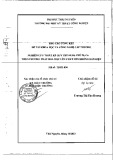
Expression and characterization of the biofilm-related and
carnosine-hydrolyzing aminoacylhistidine dipeptidase from
Vibrio alginolyticus
Ting-Yi Wang*, Yi-Chin Chen*, Liang-Wei Kao, Chin-Yuan Chang, Yu-Kuo Wang, Yen-Hsi Liu,
Jen-Min Feng and Tung-Kung Wu
Department of Biological Science and Technology, National Chiao Tung University, Hsin-Chu, Taiwan, China
Vibrio alginolyticus is one of twelve recognized marine
Vibrio species that have been identified as pathogenic
for humans and marine animals. This species causes
infection in shrimps, fish, shellfish and squids, as well
as in humans who are infected via consumption of
undercooked seafood or exposure of wounds to warm
seawater in coastal areas [1–3]. V. alginolyticus infects
grouper culture by forming a biofilm in the intestine
and causes fish mortality due to gastroenteritis syn-
drome [4]. A disease outbreak of shrimp farming in
1996 was also attributed to V. alginolyticus virulence
[5]. In infected humans, clinical symptoms include gas-
troenteritis, wound infections and septicemia [6–8] and,
more rarely, ear infections, chronic diarrhea exclusively
in AIDS patients, conjunctivitis and post-traumatic
intracranial infection [9–11]. Thus, prevention, early
Keywords
aminoacylhistidine dipeptidase; biofilm;
carnosinase; metallopeptidase H clan;
Vibrio alginolyticus
Correspondence
T.-K. Wu, Department of Biological Science
and Technology, National Chiao Tung
University, Hsin-Chu, Taiwan, China
Fax: +886 3 5725700
Tel: +886 3 5729287
E-mail: tkwmll@mail.nctu.edu.tw
*These authors contributed equally to this
work
(Received 1 May 2008, revised 5 August
2008, accepted 11 August 2008)
doi:10.1111/j.1742-4658.2008.06635.x
The biofilm-related and carnosine-hydrolyzing aminoacylhistidine dipepti-
dase (pepD) gene from Vibrio alginolyticus was cloned and sequenced. The
recombinant PepD protein was produced and biochemically characterized
and the putative active-site residues responsible for metal binding and
catalysis were identified. The recombinant enzyme, which was identified as
a homodimeric dipeptidase in solution, exhibited broad substrate specificity
for Xaa-His and His-Xaa dipeptides, with the highest activity for the His-
His dipeptide. Sequence and structural homologies suggest that the enzyme
is a member of the metal-dependent metallopeptidase family. Indeed, the
purified enzyme contains two zinc ions per monomer. Reconstitution of
HisÆTag-cleaved native apo-PepD with various metal ions indicated that
enzymatic activity could be optimally restored when Zn
2+
was replaced
with other divalent metal ions, including Mn
2+
,Co
2+
,Ni
2+
,Cu
2+
and
Cd
2+
, and partially restored when Zn
2+
was replaced with Mg
2+
. Struc-
tural homology modeling of PepD also revealed a ‘catalytic domain’ and a
‘lid domain’ similar to those of the Lactobacillus delbrueckii PepV protein.
Mutational analysis of the putative active-site residues supported the
involvement of His80, Asp119, Glu150, Asp173 and His461 in metal bind-
ing and Asp82 and Glu149 in catalysis. In addition, individual substitution
of Glu149 and Glu150 with aspartic acid resulted in the partial retention of
enzymatic activity, indicating a functional role for these residues on the
catalysis and zinc ions, respectively. These effects may be necessary either
for the activation of the catalytic water molecule or for the stabilization of
the substrate–enzyme tetrahedral intermediate. Taken together, these results
may facilitate the design of PepD inhibitors for application in antimicrobial
treatment and antibody-directed enzyme prodrug therapy.
Abbreviations
CPG2, Pseudomonas sp. carboxypeptidase G2; hAcy1, human aminoacylase-1; MH, metallopeptidase H clan; OPA, O-phthaldialdehyde;
PepD, aminoacylhistidine dipeptidase.
FEBS Journal 275 (2008) 5007–5020 ª2008 The Authors Journal compilation ª2008 FEBS 5007






























